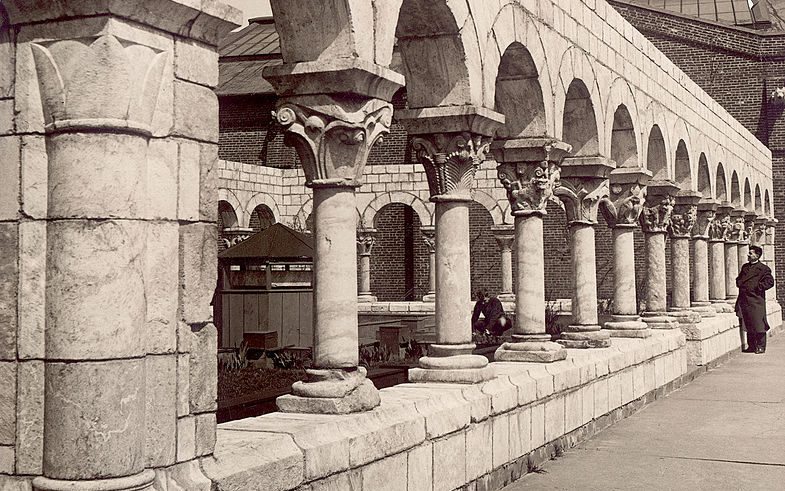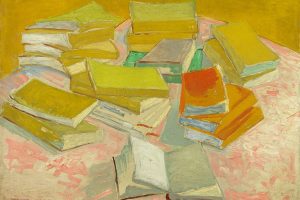Katy Hays’s involving, well-tuned debut novel takes its name from a real museum in New York, the Cloisters. Built by a Rockefeller, it resembles a medieval monastery and brims with glorious treasures. Ann, our provincial heroine (from Walla Walla, where she worked a menial job in order to fund college), would have preferred the Met, but when she’s serendipitously hired for a summer role, she finds herself swiftly pulled into the institution’s inner workings and the nefarious machinations of its well-heeled staff.
The cutthroat nature of the museum is placed under the spotlight. Although Ann is brilliant at history of art, with her lack of connections she finds it all but impossible to garner a foothold in the coveted PhD programs of the Ivy League, and views the Cloisters as a step up into a successful career. She can’t afford to get it wrong, renting a tiny apartment and avoiding phone calls from her mother to keep from being drawn back into hicksville. The irony, of course, is that in leaving a cloistered past, she’s entering somewhere even narrower.
Ann’s colleague, Rachel, is equally brilliant in her research, but has oodles of old money to cushion her way. The ingenue comes smack bang up against the sophisticate. Can small-town innocence survive? Working alongside Rachel makes Ann feel “like the artwork or document that could change my life was just around the corner.” She’s not wrong. Their supervisor, Patrick, is a handsome man with an interest in augury and tarot cards. Ann is erotically drawn not only to Patrick, but also to Leo, a playwriting gardener.
The plot stems from Patrick’s obsession with peering into the future: he seriously believes that tarot cards have power, and he’s on the hunt for an original set which he thinks will provide a groundbreaking understanding of their symbolism. We’re never, however, quite drawn into Patrick’s fanaticism, and when the characters perform readings, there isn’t much sense that something supernatural is, if you will excuse me, on the cards — it’s difficult to understand why they all care so much. When Ann stumbles on a strange find, she keeps it secret, hoping it will lead her to more, but it’s a long time before the consequences of her actions are played out. The workings of the tarot itself have no effect on events, which raises the question of why it’s there at all.
One of the novel’s concerns is inequality: Rachel is rich enough to own two apartments, as well as able to take a plane every weekend to her mansion upstate, where Dorothy Parker once stayed (leaving behind an inscribed copy of Love in a Cold Climate by Nancy Mitford). Yet Rachel doesn’t have any friends. It’s hard to believe that someone born into an upper-crust family would so entirely remove herself from the milieu: there are no parties, no country clubs, no concerned connections checking in on her. Instead, she broods by the lake. Sometimes I wish a novel would come along in which a rich person isn’t morally compromised simply by virtue of being rich; I may have to wait a while.
Ann is more complex: her father was a janitor who taught himself languages by picking up texts from the wastepaper baskets in professors’ classrooms — a talent he passed on to Ann (language, that is, not taking things from bins). As a metaphor — the poor forced to sustain themselves intellectually on the scraps of the rich — it’s a little clumsy. One finds oneself wondering why the janitor didn’t talk to a professor about taking evening classes. Leo’s role in the proceedings is also intended to highlight the systemic poverty of creatives: he’s forced to work several manual jobs in order to sustain his playwriting career and cultivates druggy plants which he sells, illegally, to rich women. Is Leo a crook? The novel says he does it because of an oppressive social system. I say, go figure.
Both Ann and Rachel are concealing darkness in their pasts. Ann’s father died in a car crash, and Rachel’s parents drowned on their lake in their own boat; Rachel barely escaped with her life. Death seems to cluster around Rachel, with the few people who had been close to her dropping off every now and again. As Ann becomes friendlier with Rachel, things become very dangerous indeed. What Ann will do to further her career becomes the major thrust of the latter part of the novel, and events spiral to a gripping conclusion.
Hays’s novel has been compared to Donna Tartt’s The Secret History with its exclusive group of people in an exclusive institution, at work upon something mystical and erudite, with murder involved and an outsider reporting on what’s happening. Though it doesn’t quite have the immediacy of Tartt’s novel, moving at a statelier pace, The Cloisters is nevertheless an involving, surprising work, marking Hays as a writer to watch. I look forward to her next with eagerness.
This article was originally published in The Spectator’s February 2023 World edition.

























